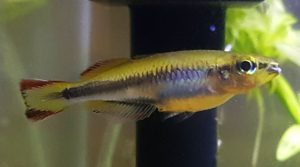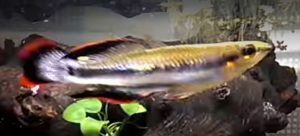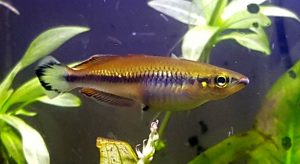The Madagascar Rainbow Fish (Bedotia madagascarensis) in found in the clear, flowing streams and waterways on the African island nation of Madagascar north of of Manambalo Creek and the middle and upper Ivoloina River.
Madagascar Rainbow Fish are collected from the small streams and lower stretches of rivers that drain into the coastal lagoons and lakes in the Atsinanana region of eastern Madagascar.
The full range of Bedotia madagascarensis is unknown to tropical fish keeping enthusiasts, however, south of Manambalo Creek and the middle to upper Ivolonia River, the Madagascar Rainbow Fish is replaced by Bedotia leucopteron, and north of the Ivoloina River by Bedotia longianalis, as well as several yet undescribed members of the genus.
Madagascar Rainbow Fish are a shoaling species that prefer living in extremely soft, clear, moderately flowing water that is partially or totally shaded by overhanging aquatic vegetation. They have been found at altitudes as high as 30,000 feet in clear mountain streams and in black water swamps in low pH, tannin stained water.
Adult Bedotia madagascarensis seem to prefer deeper water habitats where they live in smaller groups of up to several dozen specimens while juveniles tend to congregate in the shallower, marginal zones of their range.
The Madagascar Rainbow Fish (Bedotia madagascarensis) is often confused with and misidentified as Bedotia geayi, which is a valid congener native to the Mananjary River system, immediately south of its natural range.
They are most easily told apart by differences in color pattern, particularly in the unpaired fins, and some morphometric counts.
For instance, in adult male Bedotia madagascarensis, the mid lateral body stripe extends into the caudal fin giving the central caudal rays a black color. The dark area is enclosed by a silvery white or golden yellow which is surrounded by a broad dark band, and the distal tips of the fins are colored a dark red or bright white.
In male Bedotia geayi the mid lateral body stripe extends into the caudal fin to form a distinct spot which is surrounded by a thin, almost translucent border. The rest of the fin is uniformly red in color.
Male Bedotia geayi also have a red spot on their lower jaw which is absent in Bedotia madagascarensis. In addition to other morphometric differences in their fins, Bedotia madagascarensis have a longer head and snout.
In general, adult males are much more colorful and have a greater degree of color in the unpaired fins than females. Females are less colorful and fuller in the body than males, particularly when gravid.
Because they are a peaceful shoaling species, Madagascar Rainbow Fish do best when kept in groups of at least 8 to 12 individuals in a densely planted aquarium of at least 55 gallon capacity, with a sand or fine gravel substrate, some driftwood or bogwood
, some floating plants
, and a layer of Indian Almond
or other leaf litter over the substrate.
All Madagascar Rainbow Fish are intolerant of organic wastes and need spotless water conditions in order to thrive. A high quality canister or hang on outside filter and 25% to 50% water changes are needed to keep them healthy and disease free.
Madagascar Rainbow Fish can be kept in a community environment with other peaceful species, but they are better suited for a biotope system. A Madagascan community can be comprised of endemic cichlids such as Paratilapia polleni, Paretroplus menarambo, Ptychochromis oligoacanthus, etc. and a Corydora or two to clean the tank.
Bedotia madagascarensis is an egg scatter that is relatively easy to breed in an aquarium environment. They deposit their eggs in fine leaved vegetation like Java Moss, Ceratophyllum sp., floating plants, or floating nylon breeding mops.
Spawning can be accomplished by placing a pair or a small group of one male with two to three females into an aged, 20 to 30 gallon aquarium. Because the males can be quite aggressive with the females during spawning, make sure the tank is planted with some large and fine leaved plants, a few floating plants, and some driftwood roots for refuge.
The females will lay several large brown eggs daily among the fine leaved plants continuously over a period of several months until spawning is completed. The eggs are attached to the plants by fine threads and can easily be removed each day into a rearing tank or simply left with the adults until the fry hatch out. The parents ignore the eggs and the fry.
The eggs will normally hatch in 6 or 7 days at which time the fry can be offered infusoria, rotifers, paramecia, or a commercial powdered fry food until they are capable of eating newly hatched brine shrimp, usually in a week or so. Initially, the fry will swim in an oblique positon but in a few days they should start to swim normlly.
Because the fry are extremely susceptible to fluctuations in water parameters, they are considered difficult to raise. During this early period, avoid performing any water changes for at least a couple of weeks. Then only make very small changes.
Madagascar Rainbow Fish are not fussy eaters. In their natural environment they feed on terrestrial insects and other invertebrates. In an aquarium environment they will eagerly accept live, frozen, and freeze dried bloodworms, Daphnia, brine shrimp, fruit flies
, etc. along with a good quality flake or granulated food.
Bedotia madagascarensis are available to tropical fish keeping enthusiasts from specialty fish shops and online from a variety of sources at a moderate cost as juveniles and adults.
Minimum Tank Size: 55 gallons
Care Level: Easy
Temperament: Peaceful
Aquarium Hardiness: Relatively Hardy
Water Conditions: 72-89° F, dGH 10, pH 4.5 – 7.5
Max. Size: 4″
Color Form: Black, Red, White
Diet: Omnivore
Compatibility: Peaceful Shoaling Community
Origin: Madagascar, Africa
Family: Bedotiidae
Lifespan: 5 years
Aquarist Experience Level: Beginner/Advanced




